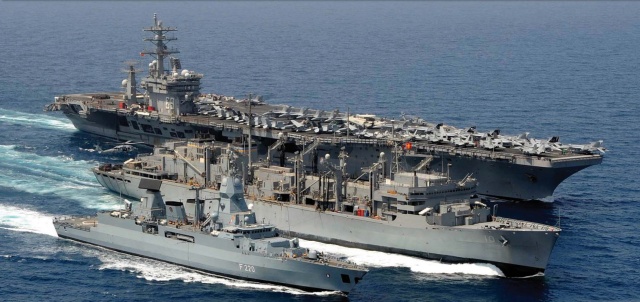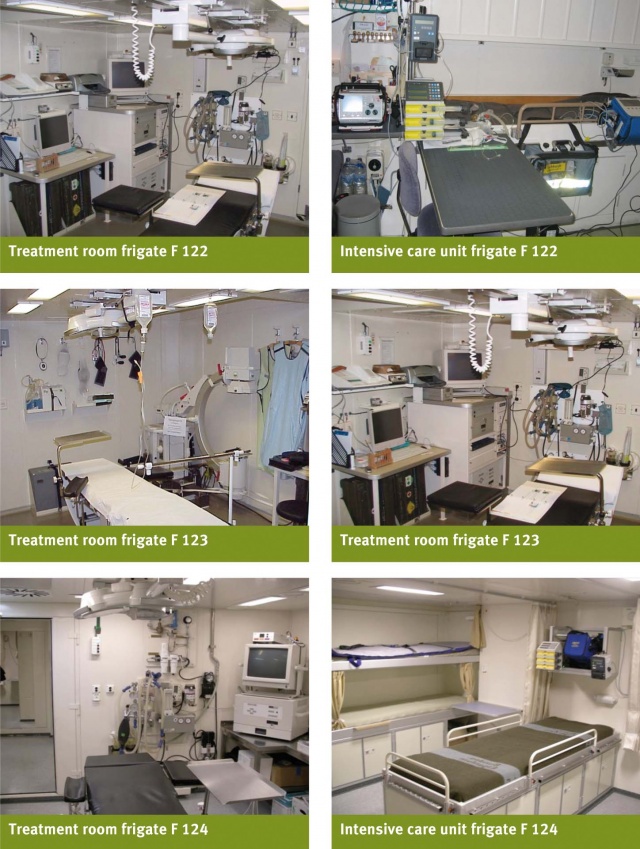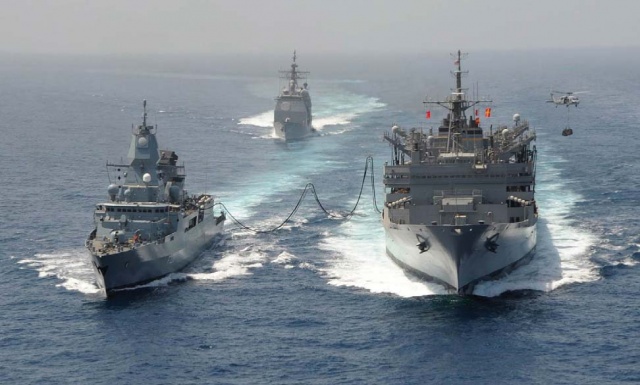
Report: M. SCHULZE, M. SIMON, H.-W. V.D. HEIDE-KATTWINKEL (GERMANY)
Diagnostic Facilities on Board Ships GER Navy
Diagnostic Facilities on board German frigates on deployment
With the end of the Cold War, the German Federal Armed Forces experienced a significant change in their scope of duties, effecting not only the GER Navy’s operations but also the kind of medical care administered on board ships.
Having played a solely defensive role, the German Federal Armed Forces started to continuously transform into an operational army. German soldiers have been participating in land, sea and air deployments the world over and been exposed to far greater risks as before. This development made it necessary to review of the provision of medical services within the German Federal Armed Forces. Medical treatment is increasingly adapting to the needs of an operational army.

A restructuring of the armed forces is another consequence of the changing conditions. For the Navy, this means a shift away from the land-based medical service and a sole focus on the provision of medical services to the mobile and airborne components of the fleet. Furthermore, the units at sea can be into two groups: Units with a physician and those without. The units with full medical provision include the frigates, which are grouped into two squadrons under the umbrella of 2nd Flotilla in Wilhelmshaven. The German Navy has 3 different frigate classes: F 122 (Bremen class), F 123 (Brandenburg class) and F 124 (Sachsen class). Medical services for their crews are provided by the group of ship's doctors. This group has the same basic structure in all three classes of vessel. Only the spatial dimensions differ on the three types of vessel.
However, the equipment available in all three ship's hospitals is of the same high standard both qualitatively and quantitatively. Consequently, for all units with a group of ship's doctors (1 doctor as medical officer, 1 paramedic, 3 emergency medical technicians), level 1 general medical and rescue-medical provision is ensured.

In addition to basic diagnostic equipment including sphygmomanometers, photometric glucometers, digital thermometers, otoscopes and a 12-channel ECG, the following can also be found on board: comprehensive laboratory equipment (equipment for testing for malaria; Reflotron®), a radiological capability (C-arm) and possibilities for non-invasive and invasive monitoring (Propaq® patient monitor).
In recent years, the medical equipment has been frequently added to and adapted to reflect progress in medical technology. This has taken place principally in the spheres of laboratory diagnostics and diagnostic imaging.
The existing laboratory equipment was expanded by adding a fully automatic diagnostic system from Abbot (i-Stat®) and the haematology system from QBC®Diagnostic (QBC-Autoread Plus System®).
In the area of diagnostic imaging, the conventional C-arm was replaced with a modern digital version.
The diagnostic imaging was also supplemented with a mobile ultrasound device from SonoSite. It is thus possible to conduct a standardised sonographic examination in the form of a focused assessment with sonography for trauma (FAST).
A dermatoscope has also been added to the basic equipment.

Depending on the risk profile of the individual mission, the group of ship's doctors may be supplemented by an emergency surgery and intensive medicine component. This involves bringing aboard an on-board medical specialist team (Bordfacharztgruppe) consisting of a surgeon, an anaesthetist, a dentist and an anaesthetist's assistant plus additional material. Level 1+ is thus provided.
The level 1+ additional equipment supplements the level 1 therapeutic equipment for example with additional surgical kits. Thanks to the expanded surgical equipment, more extensive interventions are possible in emergencies. Furthermore, the expanded surgical equipment permits exploratory laparoscopies for diagnostic purposes when medical complaints are unclear.
The set of diagnostic tools on board frigates is rounded off by a telemedicine workplace enabling the ship’s doctors to consult with other specialist physicians at home. The diagnostic system on board as a whole is designed to make communication of findings via the telemedicine workplace possible. This workplace’s additional equipment also includes a conventional single-lens reflex camera with the corresponding accessories.
An overall assessment of the diagnostic facilities on GER frigates proves that urgent surgical therapy and transport stabilisation up to the clinical provision level can be guaranteed, while the chances of survival and recovery are preserved. This fulfils the maxim of the medical service, namely that when wounded, injured or sick soldiers on deployment or when carrying out duties in circumstances equivalent to a deployment, receive medical care that ultimately meets the standards of expertise in Germany.
Date: 02/09/2014
Source: MCIF 1-14











